More on bus marketing in Pittsburgh
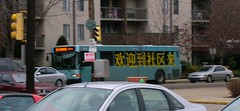 The Chinese characters on this Pittsburgh bus spell out "Welcome to the area." Flickr photo by Houshuang.
The Chinese characters on this Pittsburgh bus spell out "Welcome to the area." Flickr photo by Houshuang.As I mentioned last week, Pittsburgh uses their buses as rolling advertisements to promote transit. The most creative advertisers would kill for the reach and frequency of this most visible kind of out-of-home advertising. Transit systems own this space and can use it "for free" (well, the cost of painting the buses).
A number of Pittburgh's buses are "decorated" in foreign languages, welcoming people to the region. I was really struck by this because DC calls itself a "world class" city, and we have plenty of speakers of other languages in our city and region, but too often we don't reach out that well, at least in my opinion. Here, Pittsburgh is reaching out.
Now, don't think that I think the Pittsburgh bus system is perfect. The bus stops for the most part do not display maps of bus routes or schedules. The bus stop signs and bus shelters do not include contact telephone numbers or webpage urls for the transit authority. For the most part, bus routes listed on the signs are identified only by number. (Bus shelters have good street identification though. Pittsburgh uses Adshel for bus shelters, the same company that DC is working with to roll out new bus shelters and related services.)
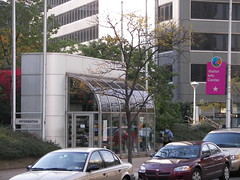 And I don't recall seeing much in the way of significant information about the transit system, a wall-mounted map (although in this space there wasn't much room) showing routes around the city, in the Visitors Center in the Gateway Center across from the Pittsburgh Hilton.
And I don't recall seeing much in the way of significant information about the transit system, a wall-mounted map (although in this space there wasn't much room) showing routes around the city, in the Visitors Center in the Gateway Center across from the Pittsburgh Hilton.Plus the otherwise great maps on tear off pads, available in most attractions, didn't seem to have transit information either.
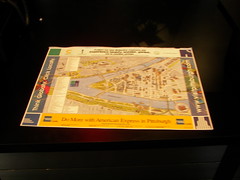 (I'll replace this with a better photo later.)
(I'll replace this with a better photo later.)But if you know how to get around a bus system, and how to find transit information, it's a pretty good system. Great headways (comparable to WMATA--and DC's bus services are particularly frequent), and I was staying near downtown and most of the bus routes use the busways on either Penn or Liberty Avenues, so access was pretty simple.
Some of the bus stops--like everywhere else I suppose--are poorly situated or even dangerous, like this stop one block from the Strip District on Liberty Avenue. (And note the very utilitarian sign--you can't get any more austere than that!)
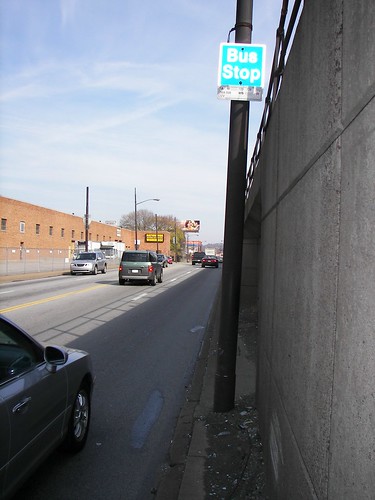
But they do some decent marketing, both on the buses, and with advertising. This kiosk ad in the Oakland neighborhood (by University of Pittsburgh, the Carnegie Institutions, and Carnegie-Mellon University) also ran in the Pittsburgh City Paper.
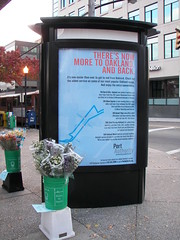
But I do think this ad would have been stronger with the addition of photos, well placed, of buses repeating the various pro-transit messages. Maybe just these four would suffice: Connect; Ride; Go; Move; etc.
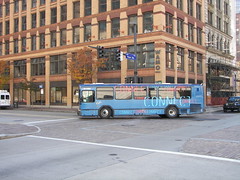
Like Portland and Seattle, travel on transit within the heart of the center city is free, although it's a relatively small area in Pittsburgh, so you end up paying to get to places like the train station or the Strip District, even though they are just a few blocks outside of the core of downtown. (The Portland "fareless square" is very large, and includes streetcar and light rail. Pittsburgh's free transit area includes its subway system.)
Finally, I wonder if buses always play second fiddle in transit systems with strong heavy (subway) and light rail systems? Pittsburgh's "subway" system is pretty insignificant, so the system has to focus on and strengthen their bus-based transportation system in order to be effective.
Gas prices got you down? Don't be a grump. Ride one of these and forget the pump.
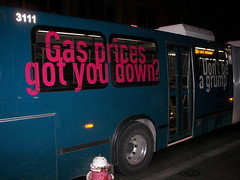 .
.Last Monday, the Richmond Times-Dispatch ran an interesting article on bus transit, "Would you know how to take the bus if you couldn't drive?" The article is profusely illustrated but the photos didn't make it to the online version of the article.
The article focuses on a college student, but extends the argument to the baby boom generation getting older and becoming unable to drive. Since mobility, especially in the suburbs, is based upon personally owned automobiles, not being able to drive becomes a form of helplessness and dependence on others--or transit.
From the article:
Sprawling people-unfriendly development doesn't lend itself to prolonged independence. The need for expensive transportation is lessened by established "livable communities" where people can get to services without driving.
Empty nesters are moving from suburban and rural areas into cities like Richmond for smaller quarters and proximity to culture, shopping and services. When they can't drive, they have alternatives in the city.
Here's the catch: If you aren't used to public transportation, you have to learn how.
To get past the fear factor, Fairfax has a brochure on how to take the bus. Louisville, Ky., has a senior riders training video. Richmond's GRTC Transit System takes buses to retirement communities to teach seniors how to ride.
Here's the kicker, in my opinion:
We need to teach everyone how to use transit, not just seniors! Starting when people are young.
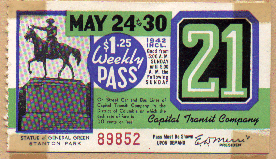 Capital Transit pass, 1942, used byThelma Yann. Image from her nephew, Steve Silivious.
Capital Transit pass, 1942, used byThelma Yann. Image from her nephew, Steve Silivious.You hear stories from so many old timers about the old Capital Transit streetcar system, how parents would buy a weekly pass to ride the system to get to and from work, and on the weekends they would give their passes to their children, to go places on the streetcar--unsupervised.
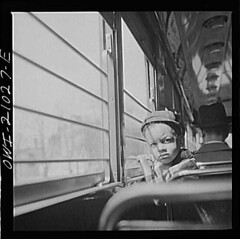 Boy on a DC Streetcar, April 1943. Bubley, Esther, photographer. OWI-FSA photo, Library of Congress.
Boy on a DC Streetcar, April 1943. Bubley, Esther, photographer. OWI-FSA photo, Library of Congress.That's how people learned how to use transit back then. Now, people have to be taught in structured ways.
Index Keywords: transit



0 Comments:
Post a Comment
<< Home